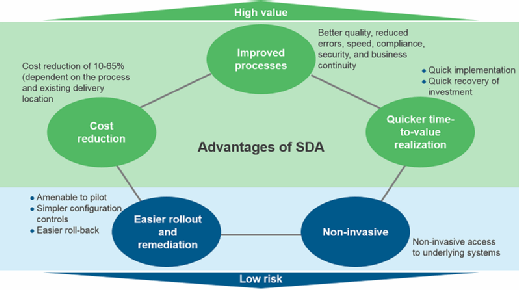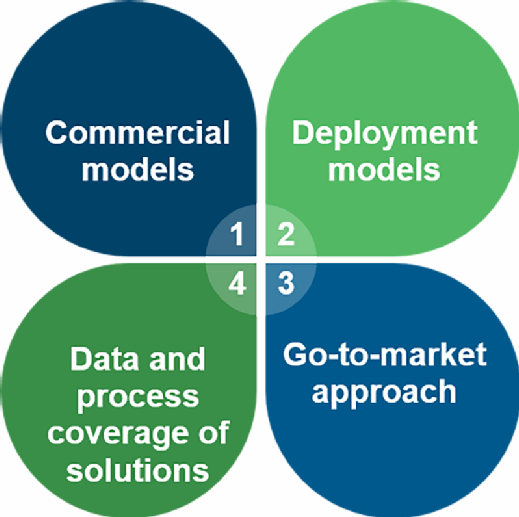
Pixelbliss - Fotolia
Demystifying service delivery automation
What is service delivery automation and what can it do for your organisation?
Like petroleum companies searching out new sources of oil, enterprises are continually seeking new ways to cut costs in their quest for competitive advantage. As one well begins to run dry, so it’s time to tap another.
As the cost compression of labour arbitrage begins to plateau, where should companies look to find the next cost-saving idea? Service delivery automation – replacing manpower with technology in service delivery – is one possibility.
Although the exploitation of technology in service delivery has a long history, the novelty of today’s approach lies in its ability to complement existing technologies with new automation that minimises disruption while offering other, newer benefits. These include reduced errors, faster operations and 24/7 coverage.
Service delivery automation is a popular topic these days, but at Everest Group we think there’s a great deal of confusion about it and how it really benefits an organisation. So let’s share some plain talk about what it truly is and what it can do for you.
What is service delivery automation?
Service delivery automation, or SDA, is an umbrella term for the technologies that automate a series of human actions in a business or IT process. It can be used to:
- Search websites and gather pertinent information
- Administer purchase orders and invoices
- Check for unusual patterns in transactions
- Handle process exceptions that can be identified and addressed using known rules
- Communicate with contacts – such as sending email confirmations
- Administer databases
- Delete IDs and reset passwords
There are numerous technologies here and many can be used in combination. Subsets include artificial intelligence (AI), plug-in architecture tools and cognitive tools. Robotic process automation – mimicking the actions a human would take in interacting with a program’s user interface to process transactions, enter data, and so on – is another subset.

“Service delivery administration can yield cost reductions of 35% to 65% for onshore process operations and 10% to 30% in offshore delivery”
Sarah Burnett, Everest Group
Those are just a few examples of technologies your company can apply to achieve greater efficiency and cost savings in business processes – whether those processes are managed in-house or through a sourcing arrangement.
What can it do for you?
Service delivery automation can lower payroll costs by automating repetitive, high-volume transactional processes. It can yield cost reductions of 35% to 65% for onshore process operations and 10% to 30% in offshore delivery. It can take just six to nine months to recover your investment.
It also gives you options. Automation can be an alternative to offshoring, as it allows you to keep work onshore by automating it. Others see it as a great way to optimise offshoring operations by further enabling consolidation and standardisation.
Beyond these obvious bottom-line contributions are other high-value benefits. For instance, it allows you to free up resources to do higher-value work. Quality, governance and compliance procedures can also be improved by embedding standards and requirements in automated processes and preserving audit trails. And consider this high-impact advantage: it can speed up processes, increasing throughput and boosting productivity. You can also scale-out automation during temporary periods of high demand.
Finally, service delivery automation is high return and low risk. The technologies are largely non-invasive – that is, they do not require major IT changes or deep integration with underlying systems, and implementations are easily remediable.

What are your options?
We estimate the supplier market to be small at present – between $65m and $75m – but expect it to grow tremendously in the coming years, particularly as pilot projects mature and the success of early adopters inspires others.
Unfortunately, when you go shopping for service delivery automation technology and integration services, you’ll find the market a bit murky. Not only do the available technologies vary considerably in their features, but also the suppliers themselves use a wide variety of go-to-market strategies and deployment models. It’s quite a challenge to compare apples to apples in that context.
Everest Group has assessed the service delivery administration technology landscape by evaluating 10 of the leading suppliers and their products on the basis of feature sets, deployment options, support, security and compliance, customer satisfaction, company size and growth, scope of customer base, and more. A simplified version of this approach is to analyse the supplier landscape along these key dimensions:
- Deployment models: desktop-based, enterprise-oriented or a mix?
- Data and process coverage: what types of data does the tool handle, and what kinds of processes can it support?
- Go-to-market approach: does the supplier sell direct, do joint development or use licensing agreements? How big is its partner network and global coverage?
- Implementation support: does the supplier offer implementation, hosting and support as well as core services, ?

What we found was a real mixture of offerings competing for market share through continuous development and enhancement. Those that started life as desktop tools have now gained enterprise features such as a centralised control module or version control. Others with roots in semi-automation for agent-assist purposes have morphed into full-blown end-to-end robotic process automation. The selection criteria should include tests for new features, including how seamlessly they work with the core technology and what difference they make to licensing and overall costs.
Then there are AI tools with their machine learning capabilities that are bringing disruption upon disruption. Some of these can interact with people through channels such as text, as well as with other machines through their application programming interfaces (APIs).
What does the future of service delivery automation hold?
In the short term, we see suppliers combining technologies in their products, an increased emphasis on resellers and implementation partners, and some suppliers developing technologies to compete with independent technology rivals.
Longer term, we see service delivery automation being embedded in enterprise software. We’ll also see changes in the industry as intelligent software becomes more sophisticated and pervasive. Intelligent software will shrink the size of the workforce needed to fulfil services, reducing the need for outsourcing, and also open up opportunities for outsourcing processes that have not been outsourced before.
Ultimately, we’ve only scratched the surface, and this is one deep well.
Sarah Burnett is research vice-president at Everest Group, an adviser to business leaders on the next generation of global services










